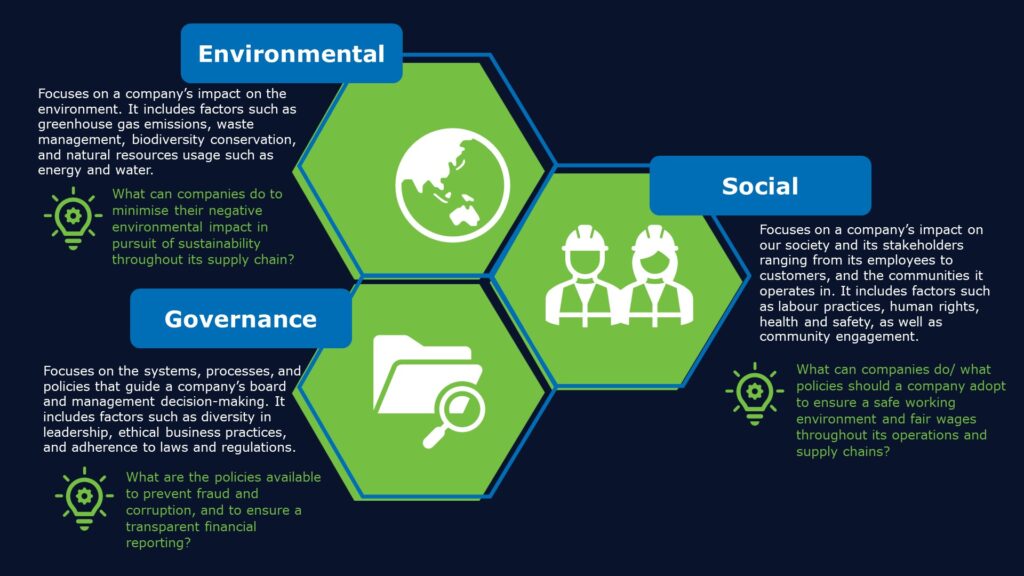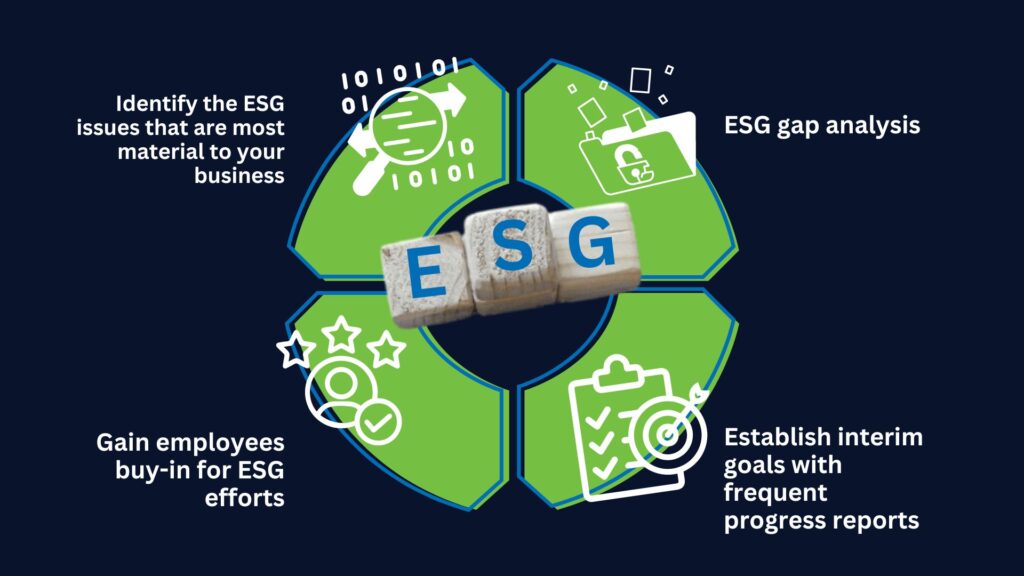At a Glance
- Companies and investors are motivated by different reasons to embrace ESG strategies
- Non-disclosure of information against ESG principles can result in reputational damage, financial setbacks, legal liabilities, supply chain disruptions, and diminished investor confidence, among others
- An ESG gap analysis serves as a roadmap for ongoing improvement
ESG (Environmental, Social and Governance) factors may not be new since the concept was coined in 2005, but it has been steadily gaining momentum, recording a significant spike in interest in 2019. Google searches for ESG skyrocketed in 2020 and the data showed that there were search queries from different regions and in different languages. Global ESG assets are expected to surpass $53 trillion by 2025, according to a Bloomberg Analysis.
ESG covers a broad spectrum of issues, but this article addresses only some of the most frequently asked questions about ESG, ranging from the risks of ignoring ESG principles to strategic approaches to developing a viable ESG framework.
Understanding ESG
When one mentions ESG, it is common to jump to environmental concerns. However, ESG is much broader than that as it covers a wide spectrum of business considerations. Here are the three pillars of ESG:
The Risks of Ignoring ESG Principles
Companies and investors are motivated by different reasons to embrace ESG strategies. Non-disclosure of information against ESG principles can result in reputational damage, financial setbacks, legal liabilities, supply chain disruptions, and diminished investor confidence, among others.
Financial performance. Effective corporate management of ESG issues often results in enhanced operational metrics, including higher return on equity (ROE), improved return on assets (ROA), and increased stock prices, according to an analysis by NYU Stern Center for Sustainable Business. Certain ESG strategies have also been shown to have the potential, over the long-term, to deliver higher returns compared to traditional investment approaches.
Supply chain disruptions. Potential dangers such as resource depletion and human rights violations within global supply chains can undermine ESG efforts. Effective vendors and third-parties management in the supply chain is crucial for large brands or corporations to mitigate these risks. The consequences of ignoring or mismanaging supply chain related to ESG factors may lead to production disruptions, thereby impacting the operations, causing delays and bottlenecks, as well as increased costs.
Legal liabilities. Governments and regulatory bodies are increasingly imposing more stringent environmental and social guidelines to address societal concerns such as climate change and labour rights. There are over 2,000 climate change-related lawsuits filed in 43 countries, as of May 2022, according to the London School of Economics and Political Science.


It’s time to step up

What you need to know about Carbon Border Adjustment Mechanism (CBAM)

It’s time to step up
Ready for a change in your organisation?
Approaches to Developing a Viable ESG Strategy and Framework
More and more companies are jumping on the sustainability bandwagon. There are four strategic approaches, each capable of initiating a transformative journey. However, it is the incorporation of all four elements that facilitates this process.
Identify the ESG issues that are most material to your business
Materiality refers to the significance of ESG factors to your company and its stakeholders including, but not limited to, shareholders, suppliers, employees, and the communities you operate in. Understanding materiality is essential to developing a viable ESG strategy. You can use the ESG Materiality Assessment to help your stakeholders prioritise the issues that are material to the business.
ESG gap analysis
A comprehensive ESG gap analysis encompasses these activities:
- Collect raw data and aggregate it to capture the material ESG programmes and initiatives that are underway.
- Analyse the aggregated data to assess the company’s current state/performance (from an ESG perspective) and how it manages its material ESG issues.
- Benchmark the aggregated data against industry best practices, and recognised ESG standards, to understand where your business falls short and how you can improve your ESG-related efforts.
An ESG gap analysis serves as a roadmap for ongoing improvement. Through this exercise, companies can establish a baseline for measuring their efforts, track their progress, and identify emerging ESG transitions within their industry. By regularly revisiting their analysis, businesses can adapt their strategies and stay ahead of ever-changing ESG expectations.
Gain employees buy-in for ESG efforts
Research indicates that obtaining employee buy-in is central to the successful implementation of ESG initiatives. Effective, strong and frequent communication of ESG social purpose can result in higher levels of employee satisfaction and engagement.
Establish interim goals with frequent progress reports
When creating a sustainability roadmap and making bold commitments, set short-, mid- and long-term goals to ensure that your goals are actionable and realistic within the project timeline.
For example, if your company commits to achieving net-zero emissions by a certain date, an interim goal would be working towards the sourcing of 100% of operational electricity from renewable energy, while decreasing scope 1 & 2 energy consumption/demand.
Begin your ESG journey here
Developing a robust ESG strategy can drive long-term business success. Renoir delivers much more than just strategies and roadmaps. We have 28 years’ experience in driving projects to full adoption using our behavioural and cultural change methodologies.
Every client’s journey is unique, shaped by their available resources and current circumstances.
Contact us for Renoir to gain a deeper understanding of your requirements.
Source:
1. Research and Analysis. ESG assets may hit $53 trillion by 2025, a third of global AUM. Bloomberg Intelligence. Published February 23, 2021.
2. Whelan, T. & et. al. ESG and Financial Performance: Uncovering the Relationship by Aggregating Evidence from 1,000 Plus Studies Published between 2015 – 2020. NYU Stern Center for Sustainable Business & Rockefeller Asset Management.
3. Welch, K. & Yoon, A. S. Do high-ability managers choose ESG projects that create shareholders value? Evidence from employee opinions. Forthcoming, Review of Accounting Studies. Published June 24, 2020.











